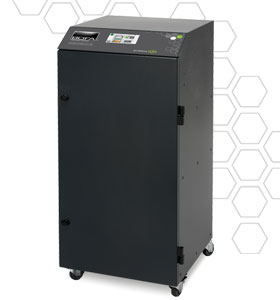Raising productivity through innovation, quality & customer support

By Geoff Sagar, Business Development Manager – Laser, BOFA International
Around the world, around the clock, manufacturers are becoming increasingly agile and employing automated processes to deliver new benchmarks in output. The safety, performance, and reliability of these systems is paramount in maintaining optimum productivity – and many rely on effective fume and dust extraction to play a part.
In the FMCG market, for example, innovations in laser technology have transformed the speed of marking and coding processes, particularly in the food and beverage industry. On some production lines where once the benchmark was to code around 50,000 products per hour, today’s laser marking lines for aluminum cans are able to operate at more than 100,000 units ph.
For operations at this scale, the pain of unscheduled downtime can be significant, which is why companies look for associated technology solutions that can be net contributors to productivity. This includes extraction systems that can filter airborne emissions which would otherwise have the potential to contaminate laser lenses and impact product quality.
Specifying such systems needs reference to Safety Data Sheets of the materials used in the laser process to understand what contaminants are to be filtered.
As a company, BOFA works closely with industry to help businesses choose the most appropriate system for their process by determining the type, volume, size, and velocity of particles being emitted. This will help companies achieve compliance with regulations that are designed to improve the workplace environment.
This information, together with data-driven airflow analyses and control parameters, will help define the optimal filtration technology, which will usually include pre-filtration, a main High-Efficiency Particulate Air (HEPA) filter, and a layer of activated carbon to help capture and contain vapors and gases.
System design should also take account of the quantity and size of particulate emitted and its chemical composition, including toxicity of each element of the process and any resultant chemical interaction.
This will inform the design of the system architecture, the filtration media used, the integration of sensors (for high-temperature applications for example), and the most appropriate monitoring and control mechanisms.
It’s worth remembering that lasering certain materials will require particular attention – for example, PVC which can give off hydrogen chloride which is corrosive and hazardous to health (HSE RR797).
Likewise, filtration systems designed for certain printing processes need to take account of potential chemical reactions, for example, those involving the use of Methyl Ethyl Ketone (MEK).
It’s not just the composition that needs to be taken into account, it’s also variables such as fume velocity, which can require complex design calculations to help manage the capture of emissions.

Maintaining optimal performance is key to productivity, which is where automated control systems, such as BOFA’s iQ2 operating system, come into their own.
This offers independent filter status monitoring, real-time system condition visualization, a color touchscreen user interface, smart navigation, enhanced alarms, and remote system upgrades.
In addition, iQ2 operating system’s extended onboard data logs can be particularly valuable for high-volume manufacturing because with increasing production line speeds, filter capacity is best measured through units of product rather than units of time. Examining these logs can provide the granular detail needed to establish optimal filter exchange patterns in step with maintenance routines to avoid the risk of unplanned downtime.
This combination of downloadable data and visual read-outs makes diagnostics smarter and quicker, no matter where in the world a production facility is based. It no longer relies on operator interpretation of data alone – the performance visualization can help establish the overall status of each element of the filtration system.
Extraction systems also need to be maintained in step with local regulatory requirements to help safeguard the contribution that filtration technology can make to productivity and to maintain its value as an important contributor to a wider health and safety program.
 To help the industry increase its understanding of extraction processes, BOFA developed the BOFA Academy, which enables customers and non-customers to access online training modules providing information and expert insights to increase their knowledge about fume filtration and its role in your overall workplace health and safety program.
To help the industry increase its understanding of extraction processes, BOFA developed the BOFA Academy, which enables customers and non-customers to access online training modules providing information and expert insights to increase their knowledge about fume filtration and its role in your overall workplace health and safety program.


